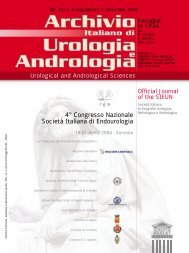7° Congresso Nazionale
7° Congresso Nazionale
7° Congresso Nazionale
You also want an ePaper? Increase the reach of your titles
YUMPU automatically turns print PDFs into web optimized ePapers that Google loves.
44<br />
<strong>7°</strong> <strong>Congresso</strong> <strong>Nazionale</strong> Associazione Italiana di Endourologia<br />
Renal stones equal or less than 1,5 cm diameter<br />
ESWL-refractory renal stones<br />
Adjuvant procedure during standard PNL<br />
Pediatric PNL<br />
Antegrade LASER endopyelothomy<br />
rigid ureteroscope (at the beginning of our experience)<br />
using a ballistic probe for lithotripsy or a LASER probe,<br />
or better a 14 Fr rigid nephroscope (6 Fr operative channel)<br />
and all flexible instrumentation. It depends on the<br />
instrument’s availability of each department. Our indication<br />
for MIPP are: renal stones equal or less than 1,5 cm<br />
diameter as first choice or SWL-refractory; as adjuvant<br />
procedure during standard percutaneous<br />
Nephrolitotripsy if it’s necessary a second access for complicated<br />
lithiasis or infra-costal approach; anterograde<br />
management of uro-enteric strictures in neobladder or<br />
ileal conduit with flexible ureteroscope and LASER incision<br />
or pneumatic dilation; antegrade endopielotomy;<br />
anterograde access to kidney transplanted for<br />
renal/ureteral lithotripsy or anastomotic strictures; pediatric<br />
nephrolithotripsy; anterograde ureteral lithotripsy<br />
when it’s impossible or complicated to a classic retrograde<br />
ureteral access; foreign body extraction (when the<br />
retrograde way is not possible); treatment of caliceal<br />
diverticula with or without calculus inside; endourological<br />
treatment of pyelocaliceal superficial transitional cell<br />
carcinoma less than 1,5 cm (Table 1).<br />
When it’s necessary to minimize a renal damage for<br />
example in patients whit renal failure or coagulation’s<br />
disorders.<br />
From January 2002 to December 2006, we treated with<br />
Archivio Italiano di Urologia e Andrologia 2007, 79, 3, Supplemento 1<br />
Table 2.<br />
Clinical Experience.<br />
First choice Nephrolithotripsy 38 pts (1 transplanted kidney; 2 with antegrade LASER<br />
endopyelothomy; 1 with lumbar stenosis dilation)<br />
ESWL- refractory stones 7 pts<br />
Adjuvant Nephrolithotripsy 9 pts<br />
Anterograde ureteroscopy for stones 1 pts<br />
Caliceal diverticula coagulation 2 pts<br />
Uretero-intestinal stenosis 4 pts (1 transplanted kidney in neobladder)<br />
Ablation of small, low grade renal TCC 1 pt<br />
Foreign body extraction 1 pt<br />
Table 1.<br />
MIPP: Our indications.<br />
Management of anastomotic strictures in entero- urinary diversions<br />
Antegrade ureteral lithotripsy<br />
Foreign body extraction when retrograde way is not possible<br />
Management of caliceal diverticula<br />
Management of small, superficial, low grade pyelocaliceal TCC<br />
MIPP, 63 patients (27 female and 36 male), mean age<br />
45+17 years (range 2-76 years); 37/63 percutaneous procedures<br />
were performed in supine position.<br />
Percutaneous lithotripsy was performed in 57/63<br />
patients, for stones of 21+10 mm burden (range 6-55<br />
mm); 1/57 was transplanted kidney; of these in 38/57<br />
pts was effected percutaneous lithotripsy as a first choice<br />
procedure; in 7/57 pts after ESWL procedure; in 2/57 pt<br />
was associated an endopyelotomy procedure with electric<br />
incision, in 2/57 pts a medial caliceal diverticulum<br />
was treated with diathermy; in 1/57 pt an infundibular<br />
stenosis was pneumatically dilated; 9/57 pts underwent<br />
adjuvant nephrolithotripsy with double access in complicated<br />
lithiasis; 2/57 pt needed a retrograde<br />
ureterolithotripsy with rigid ureteroscope for unaccesible<br />
ureter by retrograde access; 1/57 pneumatic dilation for<br />
a lombar stenosis after ureterolithotomy; 4/63 pts underwent<br />
a new recanalization for uroenteric strictures in 3<br />
neobladders (1 kidney transplant in a neobladder) and 1<br />
ileal conduit, after MIPP access a flexible ureteroscope<br />
allowed a pneumatic dilation of stenosis and a secondary<br />
LASER incision of the stenotic tract; double pig- tail stent<br />
was left for 3 weeks; in 1/63 pt was performed a LASER<br />
ablation of a small superficial transitional cell carcinoma;<br />
in 1/63 pt was extracted a ureteral stent migrated to the<br />
pelvis (Table 2).



